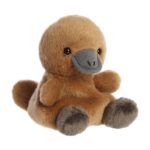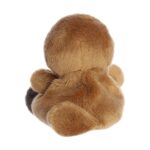Introducing, Puggle, the official mascot of STEAMfest 2024!
Did you know a puggle is a baby platypus?
Real platypuses live in Australia, but you can purchase this cute little 5″ tall plush at STEAMfest. Supplies are limited so reserve your puggle now!
Our puggle, with soft brown plush and an adorable little face, has a bean-weighted bottom so it can sit upright and be ready for anything you throw in its direction, or any direction you decide to throw it in! If you’re playing catch or just passing the time, you can toss your little bean bag platypus around and it won’t mind a bit.
Whether you are learning about real platypuses and their lives in the wild, or just hanging out and soaking up the sun on a Sunday afternoon, your puggle will be right by your side for all of it.
Each puggle comes with a Certificate of Adoption for you to complete with your puggle’s name and date of adoption, as well as some cute Platypus Facts your new puggle would like to share with you.
Puggles must be picked up in-person at Woodlawn School.
All proceeds go to support the STEAMfest mission.
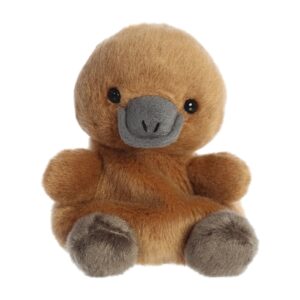
Platypus Facts
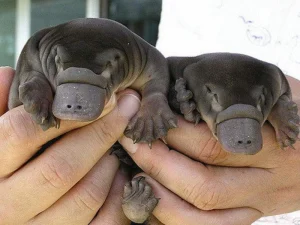
One of the most widely known platypus facts is that platypuses — yes, that’s the plural form of the word — lay eggs, a highly unusual trait for a mammal. But did you know they’re one of five mammals to do so?
The four species of echidnas, otherwise known as spiny anteaters, are also egg-laying mammals. Echidnas and platypuses are monotremes, an ancient order of animals that have many primitive traits.
In case you’re planning the world’s strangest brunch party, you might want to know that platypuses never lay unfertilized eggs, meaning there’s always a developing baby inside them. The shells are soft and leathery like reptile eggs. You sure wouldn’t want to use them in an omelet!
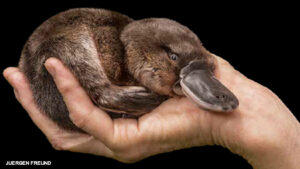
When European naturalist George Shaw was first presented with a platypus in the 1790s, he thought someone was pulling an elaborate prank. A curator of London’s Natural History Museum, he had encountered many strange animals from outside Britain’s borders, but none so exotic as a mammal with a bird beak.
However, as any good scientist would do, he diligently cut the specimen apart to look for stitches or other signs someone had cobbled the animal together, Frankenstein style. Finding none, he finally concluded it was a real species, although it would be nearly another hundred years before European scientists confirmed platypuses laid eggs.
Scientists should have just asked Aboriginal people about the animal — they had already known it laid eggs for a long time.
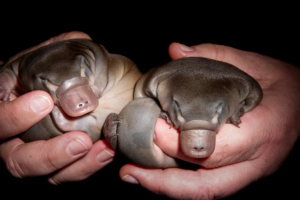
Bizarrely, platypuses lack a traditional stomach that secretes hydrochloric acid or digestive juices. It’s a pretty strange trait for a vertebrate animal, although echidnas, lungfish, some carp, and chimeras — a type of fish — also share this characteristic.
When a platypus dines on its favorite insects, shellfish, and worms, the food first goes into a small pouch-like section. This pouch contains Brunner’s glands that produce a mucus-rich fluid that aids in nutrient uptake. Finally, the food passes through the intestines.
Scientists aren’t sure why monotremes evolved to not have a true stomach, but they seem to get by just fine without one.
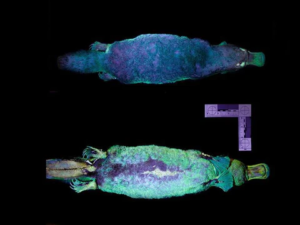
Under a UV light — also called a blacklight — platypuses light up with an otherworldly blue-green shine. Called biofluorescence, several other mammals also share this trait, including African springhares, ghost bats, wombats, and some flying squirrels.
Nobody knows why. Although the animals could use their glow-in-the-dark powers for communication, it could also be a beautiful evolutionary accident.
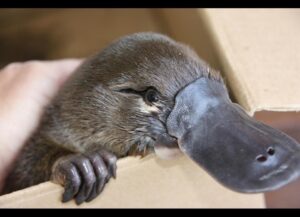 Another weird platypus fact is that male platypuses are one of the few venomous mammals on Earth. They have vicious spurs on their hind legs that deliver an excruciating toxin, possibly to help them fight other males during mating season.
Another weird platypus fact is that male platypuses are one of the few venomous mammals on Earth. They have vicious spurs on their hind legs that deliver an excruciating toxin, possibly to help them fight other males during mating season.
Although not deadly, these spurs are strong enough that a platypus can hang from them after stinging someone. Ouch!
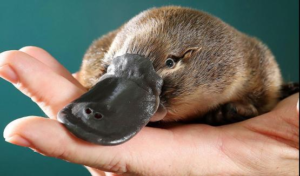
Adorably, a baby platypus is called a puggle. When a puggle first hatches, it is tiny, hairless, and pink, similar in appearance to a peeled grape. It is totally helpless and blind.
Unlike a marsupial, a mother platypus doesn’t have a pouch where the baby can continue developing. Instead, much like an altricial baby bird — the kind of chick that hatches without feathers and must rely entirely on its parents — a puggle completes its development outside the egg.
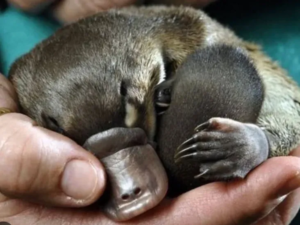
Much like a duck or goose, a platypus has a thick bill that allows it to chow down without the aid of teeth. Baby platypuses have teeth when they first hatch, but they shed them soon after they start eating a solid diet.
Rather than teeth, an adult platypus has grinding pads in its jaw to help it eat. These pads grow continuously throughout the animal’s life. Platypuses also scoop up gravel from the riverbed which helps them grind up their food.
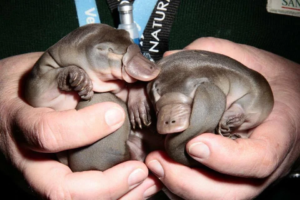 Unlike all other mammals, platypuses lack nipples. Instead, the milk seeps directly out of a mama platypus’ mammary glands and collects in grooves on her skin. Her babies lap it up or suck it out of her fur.
Unlike all other mammals, platypuses lack nipples. Instead, the milk seeps directly out of a mama platypus’ mammary glands and collects in grooves on her skin. Her babies lap it up or suck it out of her fur.
Delightfully, Sir Richard Owen — best known today as the biologist who coined the term “dinosaur” — answered the question we’re all thinking but afraid to ask. In what was perhaps one of the bravest yet most disgusting moves anyone has made in the name of science, he tasted the milk he squeezed out of a dead platypus in the London Zoo’s specimen collection.
The verdict? The yellowish milk had neither a perceptible taste nor smell, although the preserving liquor did impart a unique taste.
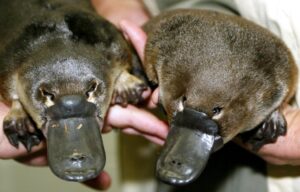
Many people know that sharks can sense electric fields, but few people know that platypuses can, too. Monotremes are the only land mammals with electroreception. The only other mammals with this superpower are Guiana dolphins, which live in the ocean.
Platypuses have 40,000 electric sensors in their bill that help them uncover hidden prey animals with ease. When your dinner is buried in the mud, that’s a pretty important skill to have.
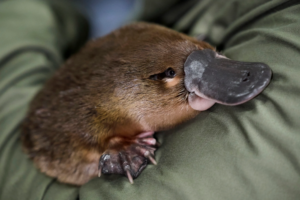 Where do monotremes get their name? “Mono” means “single,” while “treme” means “opening.” Platypuses and echidnas are the only mammals that have a cloaca, which is a single hole used for peeing, defecating, mating, and laying eggs.
Where do monotremes get their name? “Mono” means “single,” while “treme” means “opening.” Platypuses and echidnas are the only mammals that have a cloaca, which is a single hole used for peeing, defecating, mating, and laying eggs.
Reptiles, amphibians, fishes, and most birds also have a cloaca, so it isn’t rare in the animal kingdom overall, but is unusual for a mammal to have such a primitive feature. However, if it works, it works!
Platypus facts curtesy environment.co.

